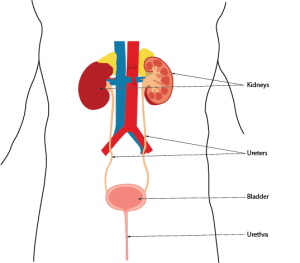When the lower part of the spinal cord is absent, the bladder is often affected, making it difficult to control the bladder. Nerves from the lower part of the spine signal the bladder to contract, to push urine out, and control the sphincter, opening to allow urine to flow out or tightening to prevent urine from leaking.
Terms and explanations:
In this image of a bladder, the ureter tubes are shown coming up from the bladder to the kidneys, which make the urine. At the bottom, the sphincter tightens to hold the urine that collects in the bladder, and releases to let the urine out. For more information about the urine excretory system, this link may be helpful: The urinary excretory system.
When we have a neurogenic bladder, the bladder does not empty urine the way it should. It doesn’t constrict to push the urine out, or the sphincter may not work the way it should.
Sometimes the sphincter is open, and it doesn’t tighten, so urine just drains out all the time. That’s actually good for the kidneys because there is no pressure on the kidneys. But it’s not good for continence, so what is good for staying dry and continent is often bad for the kidneys and what is good for the kidneys is often bad for continence. We have to balance these two issues.
If urine doesn’t empty, bacteria can grow causing a urinary tract infection. This infection can back up into the kidney-that’s called reflux, causing kidney infection and kidney damage. Also, bladder pressures from being too full put pressure on the kidney, causing kidney damage. The walls of the bladder can become stiff instead of flexible. So, we have to find ways of emptying the bladder to avoid damage to the kidneys.
Treatments that address continence and preserving the kidneys for those with a neurogenic bladder:
- Vesicostomy
- Mitofanoff
- Intermittent catheterization
- Medication
- Superpubic catheter
- Bladder augmentation
- Bladder sling
- Other surgical procedures
These treatments, and future treatments in development are further described here:
The following link (which takes a bit of time to load) is a power point presentation that may be helpful in understanding a variety of bladder and bowel procedures and treatments
